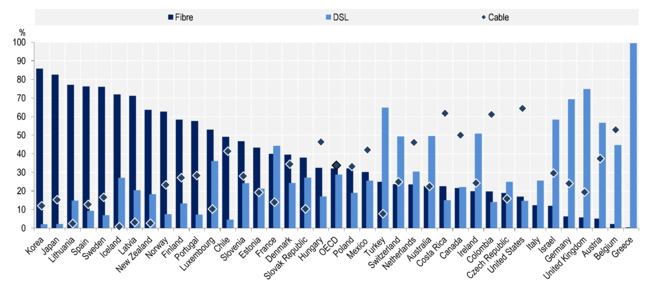Optical-fibre internet now makes up 32 per cent of fixed broadband subscriptions across the OECD countries, and is the fastest growing broadband technology. However, there is a mixed picture with cable still dominant in the Americas and the UK still predominantly DSL.
These figures come from an update to the OECD’s broadband portal, indicating that fibre subscriptions grew by 15 per cent across the OECD countries between June 2020 and June 2021, with demand for faster internet speeds as employees worked remotely due to COVID-19 restrictions cited as one reason.
Fixed broadband subscriptions in OECD countries totalled 462.5 million as of June 2021, up from 443 million a year earlier, while mobile broadband subscriptions totalled 1.67 billion, up from 1.57 billion a year earlier.
While nations across the OECD feature different mixes of broadband technologies, 23 now have a higher proportion of fibre than copper-wire DSL in their total amount of fixed broadband connections, according to the latest data. This figure is up from 20 countries just a year ago.
The greatest increases in fibre uptake appear to have been in Latin American OECD countries. Costa Rica had a growth rate of 74 per cent, with Chile at 71 per cent, Colombia at 43 per cent for, and Mexico 26 per cent. Other countries boasting impressive growth in fibre connections included Israel on 76 per cent, Ireland with 54 per cent, and Italy with 53 per cent.
Korea leads the way in terms of those countries with the highest percentage of fibre making up their broadband mix at 86 per cent, followed by Japan at 83 per cent, and Lithuania with 77 per cent. The UK lags behind with fibre broadband in single figures, cable accounting for about 20 per cent of broadband subscriptions, and DSL making up the rest.
Cable remains the dominant broadband technology across North and South America, making up 64 per cent of subscriptions in the United States, 62 per cent in Costa Rica, 61 per cent in Colombia, and 50 per cent in Canada. In Europe, cable is the dominant technology in some countries, making up 53 per cent in Belgium, and 46 per cent in Hungary and The Netherlands.
Across the OECD, DSL subscriptions declined by 6 per cent between June 2020 and June 2021, with sharp declines in some countries, such as a fall of 37 per cent in Chile and 32 per cent in New Zealand.
The OECD figures also show mobile broadband continuing to grow, with a 6.3 per cent increase in subscriptions during the year to June 2021. However, the number of data-only subscriptions actually declined in 17 out of 38 countries, which the OECD ascribes to the greater use of fixed network connections at home during home during COVID-19. ®
Fibre broadband uptake in UK lags behind OECD countries
Source: Expert Gwapo Pinoys

0 Comments